The modeling of developable surfaces is considered a very important application in plat-metal-based industries. Relating to the purpose, this discussion aims to obtain some formulas for constructing the regular developable Bézier patches, in which each boundary curve must be laid in two parallel planes. The results as follows: We find some formulas of the equation systems that are described by the constant, linear, and quadratic control parameters of the regular developable Bézier patches criteria. The new approach is numerically tested for constructing the regular developable Bézier patches, in which their boundary curves are defined, respectively, by the combination of four, five, and six degrees. Click here! (https://www.mdpi.com/2297-8747/24/1/4).
- regular
- developable Bézier patches
- control parameter
To construct the regular developable Bézier patches, in which each boundary curve of Bézier curves C1(u) and C2(u) must be laid in two parallel planes, can use regularity condition C′2(u) = ρ(u) C′1(u) with the real scalar ρ(u) > 0. Using different values of the control parameters criteria ρ(u), we will find some formulas of equation systems that can construct the family of the regular developable Bézier patches.
In case of the control parameters ρ(u) = α∈ R+ constant, we can find the regular developable Bézier patches of four degrees boundary curves, if we first determine the consecutive control points [p0,p1,p3,p4], [q0,q4] and (q4−q0)//(p4−p0). Second, we calculate α in the equations system that is formulated by the condition of the developable Bézier patches. Finally, the four variable control points [q1,q3,q2,p2] are calculated by four equations in the system. This method also applies to C1(u) and C2(u) of six degrees. The examples result are shown in Figure 1.
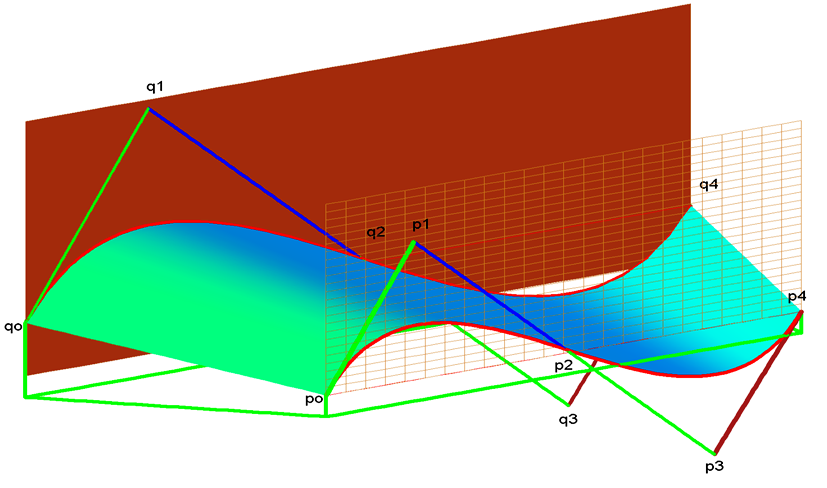
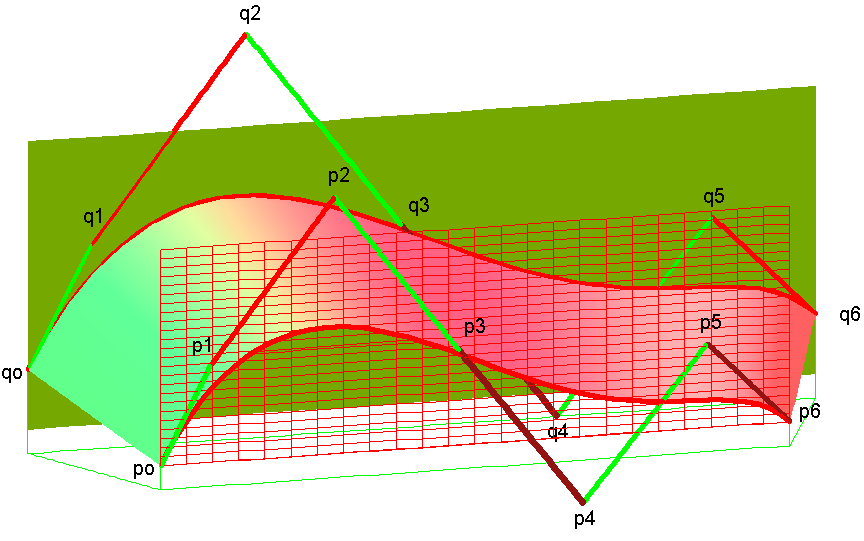
(a) (b)
Figure 1. Construction [RDBP(4,4)]C and [RDBP(6,6)]C.
Click here (https://www.mdpi.com/2297-8747/24/1/4).
In case of the control parameters ρ(u) = [α0 (1−u) + α1 u]∈ R+ linear, we can find the regular developable Bézier patches of four and five degrees boundary curves, if the points [p0,p1,p3,p4,q0,q5] are fixed. Then, we calculate α0 and α1 in the equations system in which its determinant of the coefficient matrix is different from zero, and we determine the centroid point p of Bézier polygon of the curve C1(u), such that the direction of the vectors (p−p0) and (p4−p) are in the different sides to the vector (q5−q0). Finally, we determine the five control points [q1,q4,p2,q2,q3] of the equations. This method also applies to C1(u) and C2(u) of five and six degrees. The examples result are shown in Figure 2.
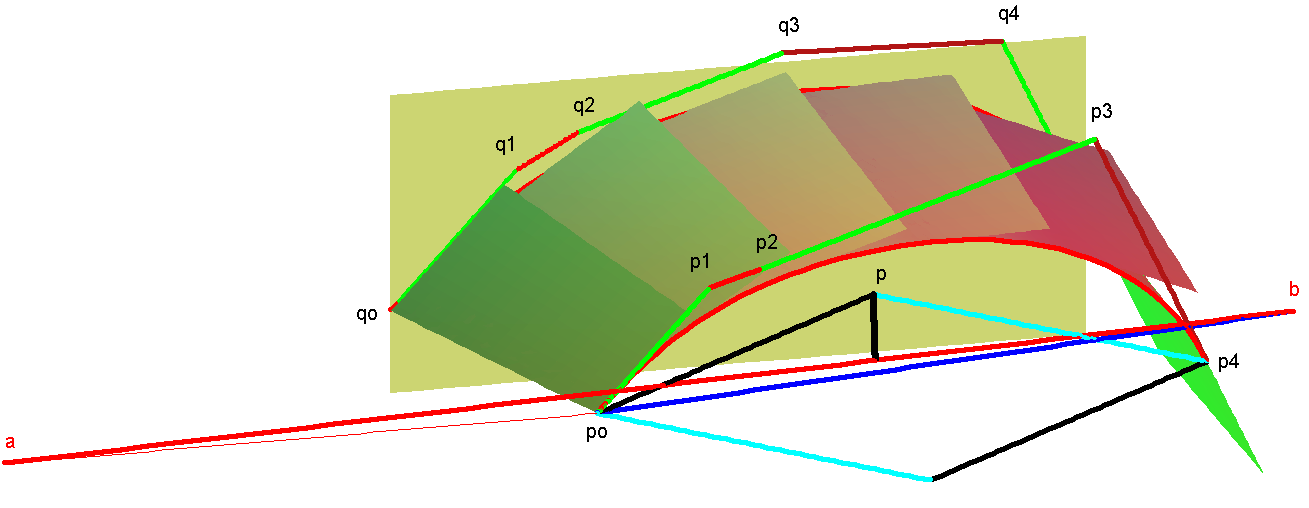
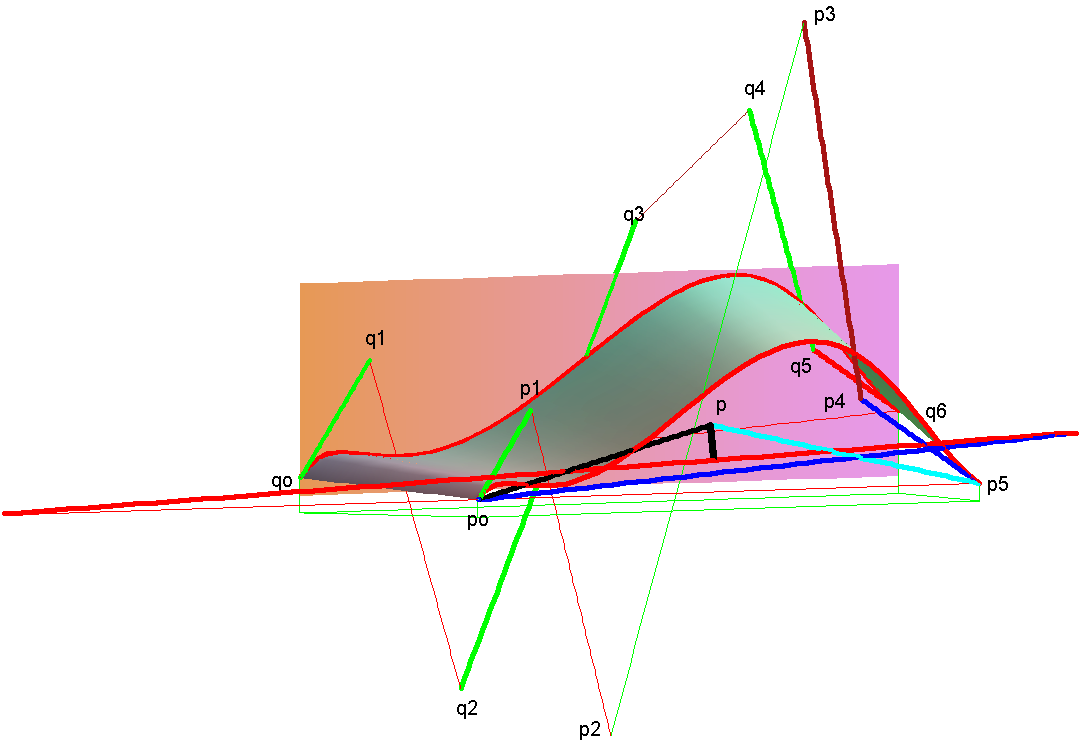
(a) (b)
Figure 2. Construction [RDBP (4,5)]L and [RDBP(5,6)]L.
Click here (https://www.mdpi.com/2297-8747/24/1/4).
In case of the control parameters ρ(u) = [α0 (1−u) + 2α1 (1−u)u + α2 u]∈ R+ quadratic, we can find the regular developable Bézier patches of four and six degrees boundary curves, if the points [p0,p1,p3,p4,q0,q6] are fixed and the elected value α1 verify the equation [(q6−q0) − α1v] = α0 (p−p0) + α2 (p5−p). In this case, we can determine the centroid point p in a position likely in the case of ρ(u) linear. Then, we calculate α0 and α1 in the equations system in which its determinant of the coefficient matrix is different from zero. Finally, we determine the control points [q1,q5,p2,q2,q3,q4] of the equations. The examples result are shown in Figure 3.
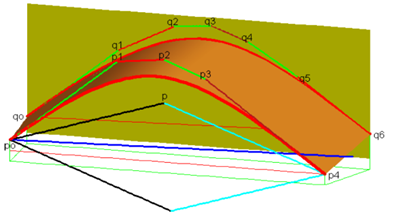
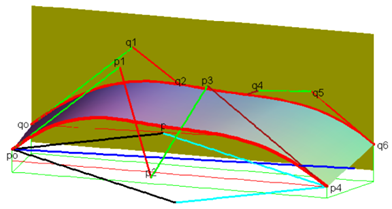
(a) (b)
Figure 3. Construction [RDBP(4,6)]Q.(a) Value α1 = 0; (b) Value α1 = 0 and position p moved down
Click here (https://www.mdpi.com/2297-8747/24/1/4).
We can conclude the results as follows. Using the determination of some Bézier control points of the curves and the parameter fixation of the developable condition, we can control and model various shapes of the Bézier developable patches. The shape of regular developable Bézier patch which is supported by two curves C1(u) and C2(u) of degree n and conditioned by ρ(u) positive constant, we note as [RDBP(n,n)]C is entirely determined by the conditions of the vectors (pn−p0)//(qn−q0) and some fixed Bézier control points for Bézier curves C1(u) and C2(u). The shape modeling of the regular developable Bézier patches with the two Bézier curves C1(u) and C2(u) of degree n and n+1, and ρ(u) positive linear, that is noted [RDBP(n,n+1)]L, depends on some fixed Bézier control points and the determination of centroid point position p of the Bézier polygon of curve C1(u). Finally, the shape of patches with ρ(u) positive quadratic, that is noted [RDBP(n,n+2)]Q, can be modeled by the fixation of some control points of the Bézier curves C1(u) and C2(u), the modification position of the centroid point p, and the given parameter value α1.
Using two curves that lie, respectively, in the plane parallel and the developable surface criteria can be designed to determine the regular developable Bézier patches of four, five, and six degrees. In further studies, discussions should focus on how to construct the developable patches in which the two boundaries are space curves and can be adjusted by some shape parameters. Click here (https://www.mdpi.com/2297-8747/24/1/4).
 Encyclopedia
Encyclopedia



